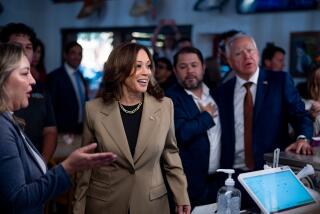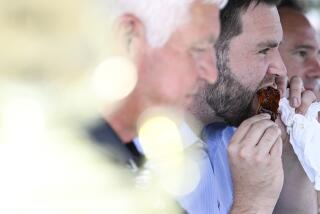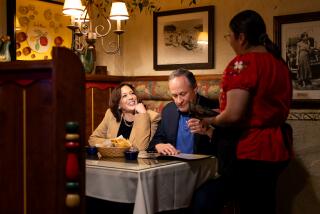Lighten Up, George
- Share via
George Bush could use some kinder, gentler eating habits. At a dinner shortly before his recent hospitalization he reportedly had steak, cottage-fried potatoes, French-fried onion rings and creamed spinach. Fat, fat and more fat; and let’s not forget that he campaigned on pork rinds and has an aversion to broccoli.
While thyroid conditions are not directly related to eating habits, overall health certainly is, especially for an aging President. “This is a good time for a nutrition evaluation,” says Mary Abbott Hess, president of the American Dietetic Assn. “Particularly after a medical scare, because it increases motivation. And certainly President Bush and his family and the nation want him to stay very healthy, for obvious reasons.”
Finding out what the President eats behind closed doors is like trying to pry out the secret formula for a nuclear weapon. (“We are not releasing that information,” said a White House spokesperson.) Still, clues from the President’s food trail--gleaned from past trips to favorite chomping grounds--reveal an image of less-than-healthy food choices.
“George loves ice cream,” says Robert Del Grande, chef and partner of Cafe Annie, who helped coordinate the Economic Summit dinner in Houston last July. “That’s why we did peach ice cream with cookies for dessert.” Del Grande noted that Bush also had Chinese food while in town for the summit.
The President showed the same tastes at a recent meeting with the prime minister of Japan. “He had ice cream with lunch, and at night, and before he left,” says executive chef Michele Pieton of the Four Seasons in Newport Beach. Bush also ate a Chinese dinner at the hotel restaurant.
The President, who likes nachos, requested them for an afternoon snack at the Four Seasons; they were served with guacamole. The next day lunch was ordered in: a Philadelphia sandwich (steak and cream cheese) with French fries. “He ate everything, he loved it,” says Pieton.
Indeed, Bush seems to clean the presidential plate when he eats a meal. “They really practice ‘waste not, want not’--they finish everything they order,” says Robert Tsui, vice president of one of Bush’s favorite Chinese restaurants, the Peking Gourmet in Arlington, Va. “His favorite dish is beef Szechuan and he also likes the Peking duck.”
Tsui contends that his duck is actually leaner than chicken (“We roast it and scrape away all the fat”). Tsui also wants to set the record straight on presidential vegetables: “He eats vegetables, by the way--just not broccoli.”
Kennebunkport is a nutritional bright spot, because there the presidential staple appears to be seafood. His favorite spot is Mabel’s Lobster Claw, says the Kennebunkport Chamber of Commerce, which also notes that Bush buys a lot of fresh fish from the local fish market when eating in. But Mabel Hanson, owner of Mabel’s Lobster Claw, brings familiar news: “His favorite dessert is buttercrunch ice cream and plain vanilla.”
Houston is another city where he eats relatively lean, at least part of the time. “President Bush definitely chooses more of the low-fat menu items,” says Ronald Kyburz, executive chef at the Houstonian Hotel, where he stays three or four times a year. Kyburz adds, though, that the hotel always has fresh homemade ice cream waiting to quench a presidential craving (“Not that he has it every single time”).
In Houston, Bush will often dine out in local restaurants that cater to his fattier eating side. He is known to patronize Otto’s Barbecue, where his favorite order is ribs, leeks, a side of beans and a beer, according to an employee who did not want to be identified.
Bush also frequents a favorite Chinese restaurant in Houston. “Generally he tells me, ‘Give me the usual,’ ” says Hunan’s owner, James Huang. “The usual” consists of Hunan beef, Hunan pork, eggplant Hunan-style, mushu pork and a house specialty, Phoenix chicken. When dining with a large group of people, he adds Peking duck. If Bush has a dessert at Hunan, it is usually a banana coated with butter and honey and deep-fried.
Huang notes that Bush has been a regular customer since the restaurant opened about 15 years ago. He proudly divulges that he was a guest at a White House dinner last year and was seated at the head table. The main course: steak.
Another food glimpse of Bush is captured in “The New American Sampler Cookbook” (Kent Sate University Press: $24.75), a recently published collection of recipes from White House and congressional notables. Bush contributed four recipes, of which two entrees are particularly fat-heavy. His “Mexican mound” includes many fatty ingredients: sour cream, avocado dip, corn chips, two pounds of meat and Cheddar cheese.
The second entree, lemon chicken, sounds nutritionally promising but calls for a cup of whipping cream and a couple of tablespoons of butter. Both entrees are fat-heavy, with 60% or more of their calories coming from fat. Bush’s other offerings are sounder: clam chowder and oatmeal lace cookies.
So what about Bush’s eating habits--ice cream, nachos, barbecue, lots of steak, Chinese food and fried foods?
“He should really manage his fat intake,” says Colleen Pierre, a member of the Advisory Board for the Nutrition Screening Initiative, whose goal is to establish a nutrition health check as a standard part of any medical exam for people older than 65. Nutritionists recommend that no more than 30% of your calorie intake be in the form of fat, but Bush’s recent steak dinner prior to his hospitalization derived nearly 60% of its calories from fat. And Bush’s dessert staple, ice cream, contains about 350 calories per cup, most of them fat calories.
What about Chinese food? “It’s really a myth that Chinese food in the United States is low in fat,” says Mindy Hermann, a New York-based nutrition consultant. “A lot of the meats are breaded and actually fried before they are put into a dish.” Also, in this country, Chinese food uncharacteristically focuses on meat.
But Chinese food does not have to be fatty, says Mary Abbott Hess of the American Dietetic Assn. She would like to see Bush order more rice, pasta and vegetables when he eats Chinese, and less meat and high-fat poultry dishes.
“With his beef he should probably choose smaller portions and have it less frequently,” says Pierre, “but relax and enjoy it when he does. He should also try some of those nonfat ice creams and frozen yogurt.”
“Almost anything will fit in (a good diet),” she adds. “it’s a matter of frequency and amount. If somebody likes ice cream and does not have a weight problem but is willing to make some other low-fat choices--then some ice cream fits in.”
The problem is that Bush does not appear to be a model of the old moderation and variety dictum. “If you eat the same thing twice in one month you haven’t explored the possibilities,” says chef Del Grande. “Imagination is the key.”
Besides Bush’s high-fat food tastes, his job is itself fraught with occupational eating hazards. “The schedules of the senators and the functions they attend make it difficult to maintain healthy eating habits,” says Janice Bissex, consulting dietitian to the U.S. Senate restaurants. “I can imagine the President would have even a more difficult time because of his schedule.” The Senate restaurants hired Bissex two years ago after senators complained that it was difficult to follow a healthy diet there.
Bush’s low weight and dedication to exercise do put him several steps ahead, from a health standpoint. However, the common notion that if you exercise and aren’t overweight, it doesn’t matter what you eat is a misconception. “There are skinny people who can have high cholesterol and high blood pressure,” says Wayne Callaway MD, a Washington-area physician who serves on the U.S. Dietary Guidelines Advisory Committee. He adds that high fat intake is associated not only with heart disease but various cancers, and merely being lean is no protection against the colon cancer that threatened President Reagan.
“It’s really important to be aware that good eating habits have a powerful affect on prevention, management and delay of chronic diseases that affect older people,” says Pierre. This is significant to Bush, who, if re-elected, will finish his second term at the age of 72.
How about it, President Bush? Time for a nutrition check-up before you hit the campaign trail? Maybe a nutrition audit is in order with a close examination of your fat budget. And perhaps a little veto action is needed in the fried-foods department.
More to Read
Get the L.A. Times Politics newsletter
Deeply reported insights into legislation, politics and policy from Sacramento, Washington and beyond. In your inbox twice per week.
You may occasionally receive promotional content from the Los Angeles Times.










